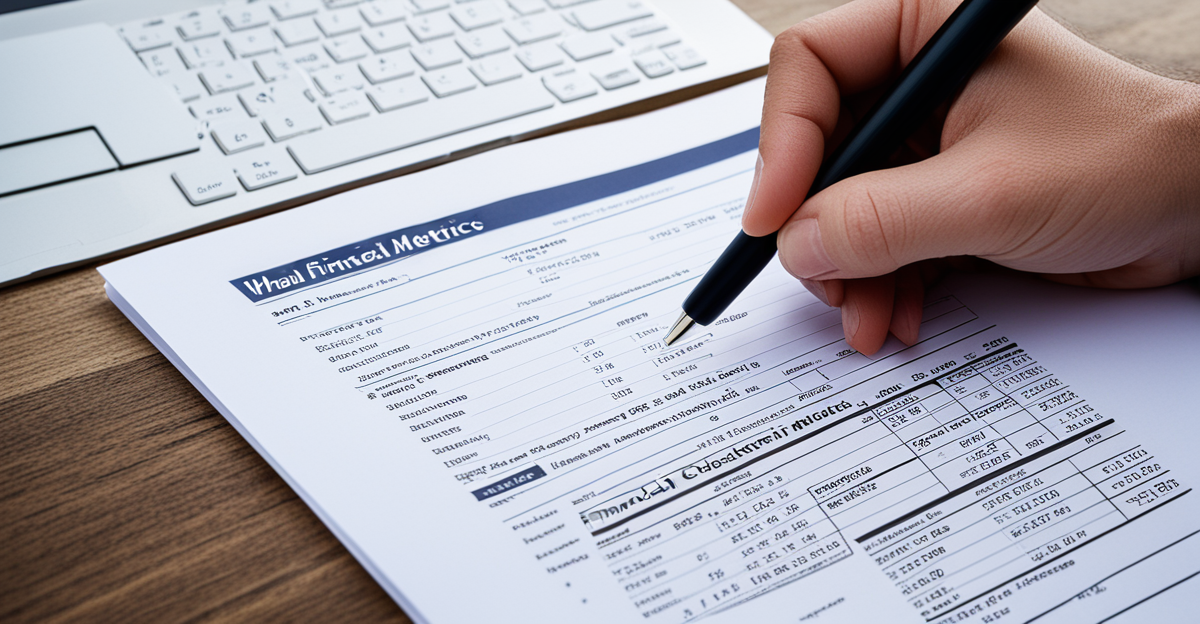Key Financial Indicators for UK Real Estate Investment
Understanding UK real estate metrics is essential for making informed investment decisions. Core financial indicators such as return on investment (ROI), yield, and net operating income (NOI) provide a clear picture of a property’s financial performance. These metrics help investors evaluate potential cash flow, profitability, and long-term value.
For example, ROI measures the efficiency of an investment by comparing the net profit to the initial cost, while yield assesses income generation relative to property value. In the UK, gross yield is commonly calculated by dividing annual rental income by the property price, expressed as a percentage. Net yield adjusts this figure by subtracting expenses like maintenance and management fees.
This might interest you : Why Are UK Property Prices Showing Such Resilience?
Immediate benchmarks vary by region and property type but typically range from 4% to 7% gross yield in prime locations. Accurate property finance assessment involves examining both these yields and additional indicators such as occupancy rates and capital growth potential.
By consistently applying these investment indicators, investors can objectively compare opportunities across UK markets, avoiding subjective biases and focusing on measurable financial risks and rewards. This data-driven approach supports sustainable profit generation and informed portfolio growth.
Topic to read : Is Real Estate Investment the Right Path for UK Finances?
Understanding Return on Investment (ROI) and Yield
Return on investment (ROI in UK property) measures the profitability of an investment by comparing net profit to the initial capital outlay. For UK property investors, ROI is calculated by dividing net income—typically rental revenue minus expenses—by the purchase price, then expressing the result as a percentage. This provides a clear, standardized indicator of how effectively capital is generating returns, helping to gauge investment efficiency.
Yield calculation is fundamental when evaluating rental properties in the UK. There are two main types: gross yield and net yield. Gross yield divides annual rental income by the property’s market value, offering a straightforward metric for income potential before expenses. Meanwhile, net yield factors in recurring costs such as mortgage payments, maintenance, and management fees, providing a more realistic estimate of actual returns.
In UK real estate, benchmarks for gross yield commonly range between 4% and 7%, depending on location and property type. For example, a property in a prime London area might have a lower gross yield due to higher prices, whereas regional cities often offer higher yields. Accurately calculating ROI and yields empowers investors to compare diverse opportunities within the UK market effectively, optimizing their property finance decisions.
Key Financial Indicators for UK Real Estate Investment
Understanding UK real estate metrics is crucial for making informed investment decisions. The core investment indicators used by property investors include metrics like Return on Investment (ROI), Yield, Capital Appreciation, Rental Income, Net Operating Income (NOI), and Cash Flow. These financial indicators help investors gauge potential profitability and risks tied to different UK properties.
Return on Investment (ROI) measures the efficiency of an investment by comparing net profit to the initial cost. Yield, another vital metric, comes in two forms: gross yield (rental income over property price before expenses) and net yield (after deducting costs like maintenance). For example, typical gross yields in the UK range between 5% and 8%, depending on location and property type.
Capital appreciation tracks the increase in property value over time, while rental income provides steady cash flow. Net Operating Income (NOI) calculates income minus operating expenses, reflecting property profitability.
Focusing on these property finance indicators guides investors to spot opportunities aligned with their goals. Immediate benchmarks vary by UK region and sector, but mastering these UK real estate metrics ensures a well-rounded investment strategy tailored to the dynamic UK market.
Key Financial Indicators for UK Real Estate Investment
The foundation of property finance decisions in the UK lies in understanding key financial indicators. UK real estate metrics such as Return on Investment (ROI), yield, and capital appreciation offer quantifiable insights that help investors assess risk and profitability. These investment indicators ensure decisions are data-driven rather than speculative.
ROI shows how effectively capital is generating profit relative to investment cost. Yield, both gross and net, measures rental income against property value and expenses, providing a snapshot of income-generating potential. Capital appreciation reflects how property values increase over time, contributing to wealth growth beyond rental returns.
Benchmarks for these metrics vary with location and property type. For instance, prime London properties tend to deliver lower yields but higher capital appreciation, while regional areas often offer higher yields with steadier cash flow. Understanding local market nuances is essential when interpreting UK real estate metrics.
Incorporating these investment indicators into financial modeling helps investors compare opportunities, forecast returns, and control exposure to market volatility. Carefully tracking these figures leads to informed, balanced property finance strategies tailored to evolving UK market conditions.
Capital Appreciation and Market Trends
Capital appreciation refers to the increase in a property’s value over time, a crucial investment indicator for UK real estate investors. Understanding capital appreciation analysis helps in predicting potential gains beyond rental income, highlighting the significance of long-term growth in property finance decisions.
UK property trends often reflect broader economic conditions, regional development plans, and demand-supply dynamics. For example, areas benefiting from transport infrastructure improvements or regeneration projects frequently show enhanced capital growth potential. Recognising such market growth indicators allows investors to target locations with promising appreciation prospects.
Assessing long-term value trends involves analysing historical price movements, demographic changes, and economic forecasts. Central London may exhibit slower appreciation due to already high valuations, whereas emerging regions like parts of Northern England often offer stronger growth opportunities. Combining these insights with other UK real estate metrics refines investment strategy, enabling balanced portfolios keyed to both income and appreciation. This approach ensures investors capture market momentum while managing risks inherent in fluctuating property markets.
Key Financial Indicators for UK Real Estate Investment
Core UK real estate metrics like ROI, yield, and capital appreciation serve as essential investment indicators guiding property finance decisions. ROI quantifies profit efficiency by comparing net gains to initial investment costs, offering a baseline for evaluating returns. Yield, both gross and net, reflects rental income relative to property value, where gross yield ignores expenses, and net yield deducts costs such as maintenance and management fees.
Benchmarking these metrics within the UK context reveals typical gross yields ranging from 4% to 7% in prime areas, with regional variations influenced by market conditions. For instance, higher yields are often found in Northern cities compared to London’s lower-yield, higher-value properties, which might offer greater capital appreciation potential. Capital appreciation itself indicates how property values increase over time, informing projections of long-term wealth growth beyond income generation.
By regularly analyzing these UK real estate metrics, investors can align their property finance strategies with local market nuances. This includes assessing investment risks, estimating expected returns, and comparing opportunities across residential and commercial sectors. These well-defined investment indicators empower decision-makers to build a balanced portfolio that responds effectively to evolving UK market dynamics.
Key Financial Indicators for UK Real Estate Investment
UK real estate metrics form the backbone of sound property finance decisions. Core investment indicators include Return on Investment (ROI), yield, capital appreciation, rental income, and net operating income (NOI). These metrics quantify profitability and risk, helping investors navigate diverse UK markets.
ROI reflects the efficiency of capital deployment, calculated by dividing net profit by the initial investment cost. Yield, expressed as gross or net, gauges income relative to property value and expenses. While gross yield shows income before costs, net yield subtracts operating expenses, presenting a clearer income picture. Both yields typically range from 4% to 8% based on region and property type.
Capital appreciation measures the property’s value increase over time, critical for wealth accumulation beyond rental returns. Rental income and NOI focus on ongoing cash flow. NOI specifically subtracts operational costs from income, indicating real profitability.
These UK real estate metrics provide immediate benchmarks to compare opportunities. For example, prime London properties may have lower yields but higher capital growth, whereas regional locations often offer stronger income yields. Understanding and applying these investment indicators enables investors to make data-driven, balanced decisions in the dynamic UK property finance landscape.
Key Financial Indicators for UK Real Estate Investment
Core UK real estate metrics like Return on Investment (ROI), yield, and capital appreciation serve as crucial investment indicators that underpin sound property finance decisions. These metrics quantify profitability and risk, enabling investors to evaluate potential returns by comparing net income, income-generating capacity, and asset growth over time.
ROI in UK property measures the efficiency of capital use by dividing net profit by the initial investment cost, offering an essential benchmark to assess investment viability. Yield calculation further dissects income potential through gross and net yield metrics: gross yield considers rental income relative to purchase price before expenses, while net yield subtracts ongoing costs such as maintenance and fees. Both provide insights into expected cash flow and profitability.
Immediate benchmarks in UK real estate show gross yields typically range between 4% and 7% in prime locations, with variations depending on property type and region. For instance, properties in high-demand London areas might exhibit lower yields but benefit from stronger capital growth, whereas regional cities often provide higher yields for reliable rental income. Understanding and applying these UK real estate metrics guides prudent investment strategies aligned with market dynamics.
Key Financial Indicators for UK Real Estate Investment
Core UK real estate metrics offer vital insights that shape property finance decisions. For investors, key investment indicators include Return on Investment (ROI), yield, and capital appreciation, each quantifying different aspects of profitability and risk. Understanding these metrics enables clear evaluation of potential returns and market risks.
ROI in UK property measures the efficiency of capital use by comparing net profits to initial investment costs. Yield assessment, including both gross and net yield, gauges income generation relative to property value and recurring expenses. For instance, gross yield overlooks costs, while net yield factors in management fees and maintenance, providing a more accurate income picture.
Immediate benchmarks help contextualize these figures. Typical gross yields in UK urban areas range between 4% and 7%, with higher yields often found outside London, where property values are lower. Capital appreciation tracks value increases over time, crucial for long-term wealth accumulation.
By integrating these UK real estate metrics into financial modeling, investors refine their property finance strategies, enabling informed decision-making that balances income production and capital growth potential across diverse UK markets.
Key Financial Indicators for UK Real Estate Investment
Understanding core UK real estate metrics is vital for effective property finance decisions. These investment indicators include Return on Investment (ROI), yield, and capital appreciation, each offering unique insights into investment potential.
ROI measures net profit relative to the initial capital outlay, providing a clear gauge of investment efficiency. Yield focuses on rental income; gross yield calculates income before expenses, while net yield adjusts for costs like maintenance and management fees. These differences make net yield a more realistic metric for assessing income-generating capacity.
In the UK market, immediate benchmarks for gross yields typically range from 4% to 7%, varying by region and property type. Prime London properties often offer lower yields but stronger capital appreciation, while regional areas provide higher yields with steadier income. Capital appreciation tracks the increasing value of assets over time, contributing to long-term wealth beyond rental returns.
Applying these UK real estate metrics enables investors to compare opportunities systematically. By integrating these investment indicators into financial modelling, investors can forecast returns accurately and tailor property finance strategies that align with both market conditions and individual objectives.
Key Financial Indicators for UK Real Estate Investment
In UK property finance, UK real estate metrics such as Return on Investment (ROI), yield, and capital appreciation form the cornerstone of sound decision-making. These investment indicators measure profitability, risk, and growth potential, enabling investors to objectively assess various opportunities.
ROI quantifies investment efficiency by comparing net profit to the initial outlay, providing a clear gauge of performance. Yield, split into gross and net forms, reflects rental income relative to property value, with gross yield omitting expenses and net yield factoring in operating costs. Typical UK real estate metrics set gross yield benchmarks between 4% and 7% in prime areas, with net yield slightly lower after expenses, helping investors understand real income potential.
Additionally, capital appreciation signals asset value growth over time, integral to long-term wealth accumulation in UK markets. Investors must interpret these investment indicators within local market contexts, recognizing how regional and property-type variations influence expected returns and risks.
By consistently applying these core UK real estate metrics, property finance strategies become more precise, facilitating comparisons across regions and sectors. This data-driven approach enhances the ability to balance immediate income with growth prospects, ensuring well-informed investment decisions aligned with UK market dynamics.
Key Financial Indicators for UK Real Estate Investment
Core UK real estate metrics such as Return on Investment (ROI), yield, and capital appreciation are essential investment indicators for evaluating property finance opportunities. Investors rely on these metrics to measure profitability, assess risks, and guide decisions across diverse UK markets.
ROI calculates how efficiently capital is used by dividing net profit by the initial investment cost. This quantifies overall investment performance, providing a clear benchmark for UK property finance evaluation. Yield, expressed as gross and net, measures income relative to property value. Gross yield divides annual rental income by purchase price, showing potential returns before expenses. Net yield refines this by subtracting ongoing costs such as maintenance, management fees, and taxes, offering a realistic picture of income.
Immediate benchmarks for these metrics differ by location and property type. For instance, gross yields in prime London often range from 3.5% to 5%, while regional cities may reach 6% to 7% or higher. Capital appreciation complements yield, tracking property value growth over time. Together, these investment indicators create a comprehensive framework for assessing the financial viability and sustainability of UK property investments.
Key Financial Indicators for UK Real Estate Investment
Core UK real estate metrics include essential investment indicators like ROI, yield, and capital appreciation, which are foundational for effective property finance. ROI measures profitability by comparing net profit to the initial capital invested. Yield calculation, divided into gross and net yield, evaluates income generation relative to property value; gross yield ignores costs, whereas net yield deducts expenses such as management fees and maintenance.
Understanding these UK real estate metrics helps investors assess the financial viability of properties across diverse markets. For instance, gross yields commonly range between 4% to 7% in prime UK locations, with regional variations reflecting differing market dynamics. Investors use these benchmarks to balance income potential and risk exposure.
These investment indicators also assist in forecasting performance by offering quantifiable data on cash flow and asset growth. Crucially, they enable comparisons between residential and commercial property investments, aiding strategic allocation of resources. By closely monitoring metrics like ROI and yield, property finance decisions become data-driven, reducing speculation and supporting sustainable returns within the UK market’s evolving landscape.








